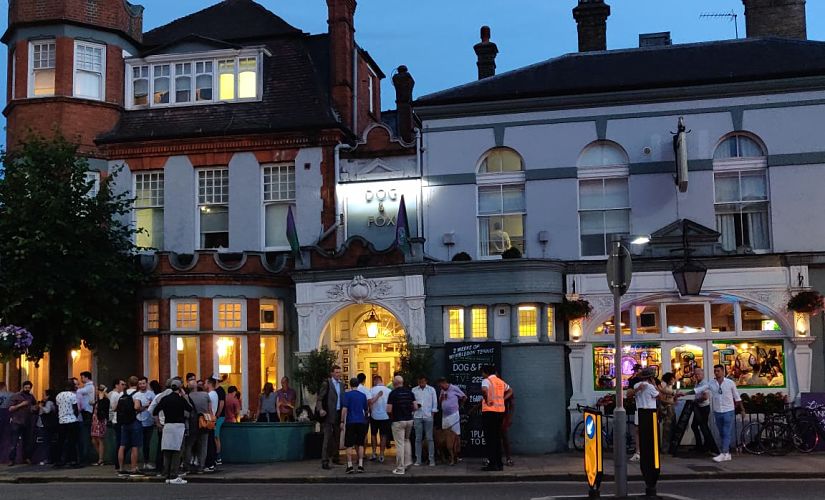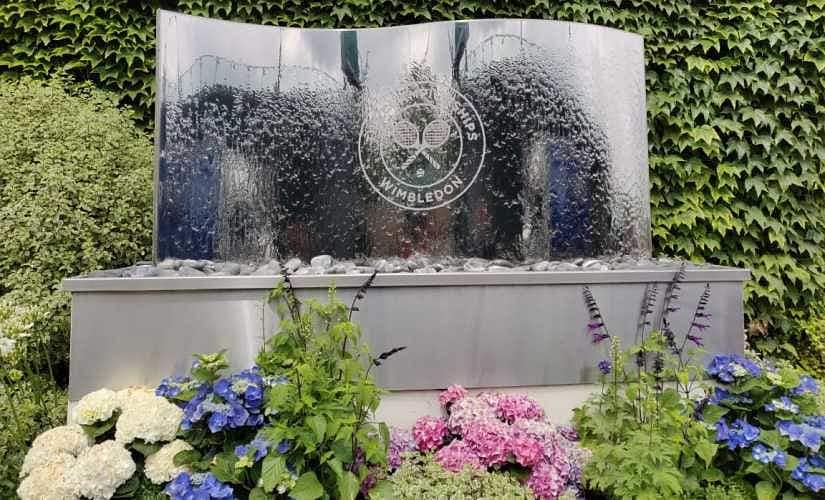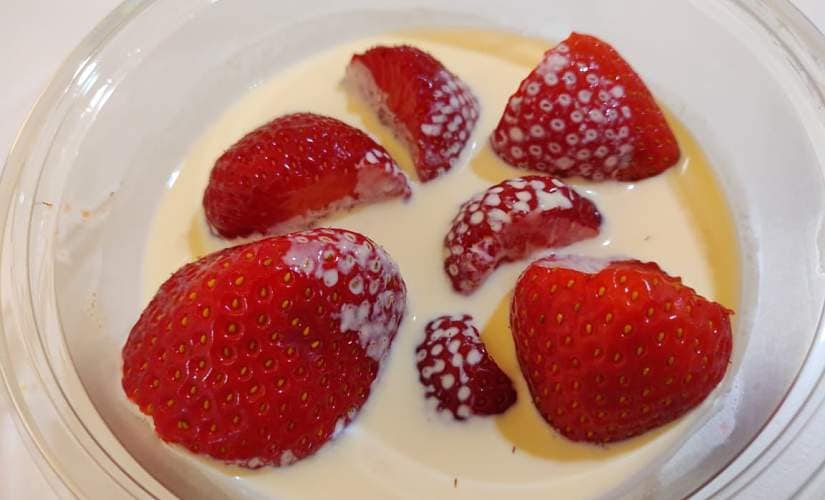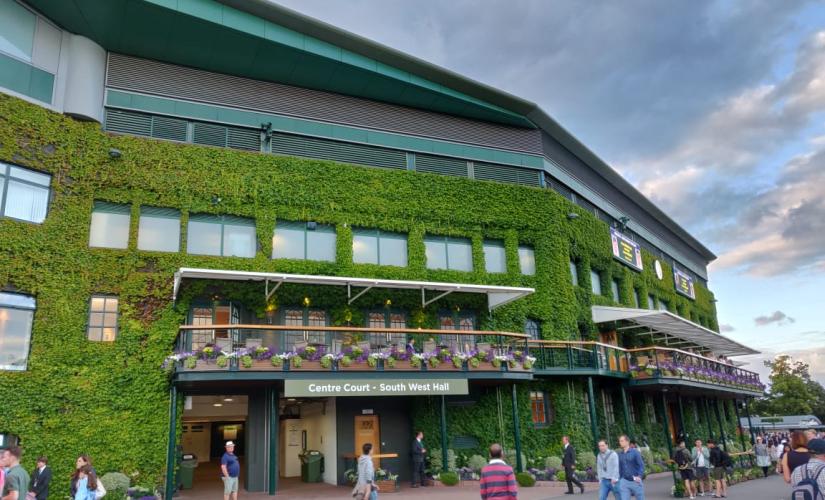Can a tournament be an idea more than an event? Looking from afar, Wimbledon does loosely fit that description. Almost everything about it sounds like mythical lore rather than an actual occurrence in reality. The aura, the traditions, even the surface tennis is played on (grass as a surface went out of commission everywhere else a couple of decades ago) and the outfits of the players – they all make Wimbledon feel like a relic of time. Does it feel the same way when you’re actually at the tournament, watching everything unfold in person? As a first time attendee this year I found some of the traditions archaic and at times needless, but I realised they are not the only things that make up the Wimbledon experience. Instead, the traditions act as indulgent little ancillary elements that add to the heft of the action and make it all seem larger than life. Wimbledon is first and foremost a celebration of tennis, a temple that houses the best serves and forehand in the game. The time-honoured customs are like the pinch of salt that enhances the flavours in any baked product; Wimbledon’s traditions somehow make those serves and forehands feel just a little bit more memorable. So which of the traditions contribute most significantly to that ‘flavour enhancement’ and which are overrated? I’ll try and tackle them one by one, going in chronological order. [caption id=“attachment_6977901” align=“alignnone” width=“825”] The two-mile walk from Wimbledon station to the All England Club is worth the effort. Image: Musab Abid[/caption] First, getting to the grounds: unlike the other Slams, the Wimbledon train station is located a good 2 kilometres away from the stadium. That means you have to walk nearly 25 minutes to get there (unless you’re travelling by cab, but let’s face it – that is neither fun nor pocket-friendly). There is a bus shuttle service that takes you from the station to the Club too, but again that costs nearly 4 pounds one way – which is not something you want to be shelling out if you’ve already spent a bomb on the tickets. So the trek to the grounds is pretty much your best option, but it’s worth the effort. The entire pathway from the station to the grounds is lined with lush greenery and dotted with banners and flower arrangements in the trademark purple and green colours of Wimbledon. As you walk past the affluent SW19 neighbourhood filled with cute little cottage-style houses, you are automatically put into the mood for some good old-fashioned British merriment. And if you’re in the mood for some food or drink after you’ve had your fill of tennis for the day, you can hop into the popular bar Dog & Fox (made even more famous this year by Nick Kyrgios’ visit to the place before his match against Rafael Nadal) on your way back to the station. There are also legendary eateries like Paul’s and Ivy Cafe that form part of the to-do list of most Wimbledon visitors. [caption id=“attachment_6977881” align=“alignnone” width=“825”]
 If you’re in the mood for a pint, hopping over to the Dog & Fox pub near the club is a good option. Image: Musab Abid[/caption] Next comes the queue, which is just outside the grounds. This is perhaps the most impractical and unnecessary of all the Wimbledon traditions because it just takes up too much of your time. You can technically get tickets online too, but the difficulty and cost involved in that means that it’s almost necessary for the regular fans to queue up for hours on end every day. There’s a fair bit of luck involved in this tedious exercise too. On some days you can get Centre Court tickets after standing in queue for just 3-4 hours, but on others, you have to wait for an entire day or more (people start queuing up at 5 am or earlier). If you’re looking just for a grounds pass though (which gives you access to all courts except Centre, Court 1 and Court 2), you could come in a bit later in the day and get in at a cost of just 20 pounds. A grounds pass allows you to experience another famous tradition: watching a match on Henman Hill. The crowd lounging around the elevated patch of grass is usually quite cheerful and boisterous, so joining them in front of the giant screen isn’t the worst way to spend your day at SW19. [caption id=“attachment_6977891” align=“alignnone” width=“825”]
If you’re in the mood for a pint, hopping over to the Dog & Fox pub near the club is a good option. Image: Musab Abid[/caption] Next comes the queue, which is just outside the grounds. This is perhaps the most impractical and unnecessary of all the Wimbledon traditions because it just takes up too much of your time. You can technically get tickets online too, but the difficulty and cost involved in that means that it’s almost necessary for the regular fans to queue up for hours on end every day. There’s a fair bit of luck involved in this tedious exercise too. On some days you can get Centre Court tickets after standing in queue for just 3-4 hours, but on others, you have to wait for an entire day or more (people start queuing up at 5 am or earlier). If you’re looking just for a grounds pass though (which gives you access to all courts except Centre, Court 1 and Court 2), you could come in a bit later in the day and get in at a cost of just 20 pounds. A grounds pass allows you to experience another famous tradition: watching a match on Henman Hill. The crowd lounging around the elevated patch of grass is usually quite cheerful and boisterous, so joining them in front of the giant screen isn’t the worst way to spend your day at SW19. [caption id=“attachment_6977891” align=“alignnone” width=“825”] Watching matches on Henman Hill among a boisterous crowd is an experience in itself. Image: Musab Abid[/caption] But back to the queue: many people consider standing in it to be fun, as the atmosphere can be fairly carnival-like with so many fellow tennis enthusiasts desperate to get a piece of the action. But if you’re not someone who has all the free time in the world, this is one tradition that feels like a punishment for being a tennis fan. Once you enter the grounds, the sheer beauty and majesty of the grounds hit you. The entire arena is draped with vegetation of all kinds; there are the archetypal purple flowers all over the place, and the imposing Centre Court façade is covered from top to bottom by ivy. The flowers and greenery at Wimbledon are such a big part of Wimbledon that Roger Federer and Novak Djokovic were asked about them after their respective quarter-final wins. “I always liked the ivy. I know there are a lot of flowers, especially that sort of first week, the practice week. When we wander around the grounds, we get a bigger chance to enjoy them,” Federer said. [caption id=“attachment_6977921” align=“alignnone” width=“825”]
Watching matches on Henman Hill among a boisterous crowd is an experience in itself. Image: Musab Abid[/caption] But back to the queue: many people consider standing in it to be fun, as the atmosphere can be fairly carnival-like with so many fellow tennis enthusiasts desperate to get a piece of the action. But if you’re not someone who has all the free time in the world, this is one tradition that feels like a punishment for being a tennis fan. Once you enter the grounds, the sheer beauty and majesty of the grounds hit you. The entire arena is draped with vegetation of all kinds; there are the archetypal purple flowers all over the place, and the imposing Centre Court façade is covered from top to bottom by ivy. The flowers and greenery at Wimbledon are such a big part of Wimbledon that Roger Federer and Novak Djokovic were asked about them after their respective quarter-final wins. “I always liked the ivy. I know there are a lot of flowers, especially that sort of first week, the practice week. When we wander around the grounds, we get a bigger chance to enjoy them,” Federer said. [caption id=“attachment_6977921” align=“alignnone” width=“825”] One can find purple flowers all over the grounds which adds to the beauty and majesty of the club. Image: Musab Abid[/caption] Djokovic more or less echoed those thoughts: “They’re beautiful, yeah. I actually like the early hours of the day before the public and the crowd comes in. That’s when you can actually move around freely as a player. That’s where you notice how much effort and time people who are working in the organization, management here, you know, how much time and effort they’re investing into making this club probably the most famous tennis club in the world.” The ‘most famous tennis club’ also has the most famous tradition: strawberries and cream. You can’t escape strawberries and cream when you’re at Wimbledon; every single food section has a dedicated stall for it. I personally found the snack to be a little overrated; it’s just strawberries and cream at the end of the day, you know? But you feel almost compelled to have it when there are so many people around you happily slurping on the red fruit. In a bit of a twist on tradition, Wimbledon has also now introduced a vegan version of strawberries and cream, substituting regular cream for soy cream. Progressiveness is certainly something that’s being embraced by the All England Club with increasing regularity. [caption id=“attachment_6977941” align=“alignnone” width=“825”]
One can find purple flowers all over the grounds which adds to the beauty and majesty of the club. Image: Musab Abid[/caption] Djokovic more or less echoed those thoughts: “They’re beautiful, yeah. I actually like the early hours of the day before the public and the crowd comes in. That’s when you can actually move around freely as a player. That’s where you notice how much effort and time people who are working in the organization, management here, you know, how much time and effort they’re investing into making this club probably the most famous tennis club in the world.” The ‘most famous tennis club’ also has the most famous tradition: strawberries and cream. You can’t escape strawberries and cream when you’re at Wimbledon; every single food section has a dedicated stall for it. I personally found the snack to be a little overrated; it’s just strawberries and cream at the end of the day, you know? But you feel almost compelled to have it when there are so many people around you happily slurping on the red fruit. In a bit of a twist on tradition, Wimbledon has also now introduced a vegan version of strawberries and cream, substituting regular cream for soy cream. Progressiveness is certainly something that’s being embraced by the All England Club with increasing regularity. [caption id=“attachment_6977941” align=“alignnone” width=“825”] While there’s nothing really special about the famous strawberries and cream, one can’t help but succumb to peer pressure. Image: Musab Abid[/caption] And what of the drink that usually accompanies strawberries and cream in those Wimbledon ads? Pimm’s is pretty much everywhere too, but I noticed that it was matched in popularity by Stella Artois lager. Maybe it’s because gin is not as much of a common folk drink as beer, or maybe because Pimm’s is slightly costlier than Stella Artois, but this is one tradition that could well be on its way to changing a little. One tradition that doesn’t seem likely to change any time soon is that of the tennis-free Middle Sunday. With the newly installed roof on Court 1, the chances of rain postponing matches by more than a day are almost non-existent now — thus precluding the necessity of holding matches on Sunday to make up for lost time. As a TV viewer I have always hated Middle Sunday; how does it make any sense to stop play just when the action has reached its peak? But when you’re at the venue you do welcome the breather after six days of breathtaking tennis. The ground staff, the broadcasters, even the players themselves – everyone comes back refreshed for Manic Monday after the day off and that inevitably helps produce some of the greatest spectacles the sport has to offer. One tradition that isn’t really a tradition at all is the supposedly aristocratic vibe of Wimbledon. There is a perception among some that anyone attending the Championships is required to be dressed impeccably to match the class of the environs, while also keeping their voices low and their behaviour at its most polished. In reality, there are no such requirements. You can wear whatever you want (including tank tops and flip-flops) without being frowned upon, and there are no restrictions on noise levels. It’s true that Wimbledon isn’t quite the carnival that is the Australian Open, but it isn’t a posh and exclusive club either. [caption id=“attachment_6977861” align=“alignnone” width=“825”]
While there’s nothing really special about the famous strawberries and cream, one can’t help but succumb to peer pressure. Image: Musab Abid[/caption] And what of the drink that usually accompanies strawberries and cream in those Wimbledon ads? Pimm’s is pretty much everywhere too, but I noticed that it was matched in popularity by Stella Artois lager. Maybe it’s because gin is not as much of a common folk drink as beer, or maybe because Pimm’s is slightly costlier than Stella Artois, but this is one tradition that could well be on its way to changing a little. One tradition that doesn’t seem likely to change any time soon is that of the tennis-free Middle Sunday. With the newly installed roof on Court 1, the chances of rain postponing matches by more than a day are almost non-existent now — thus precluding the necessity of holding matches on Sunday to make up for lost time. As a TV viewer I have always hated Middle Sunday; how does it make any sense to stop play just when the action has reached its peak? But when you’re at the venue you do welcome the breather after six days of breathtaking tennis. The ground staff, the broadcasters, even the players themselves – everyone comes back refreshed for Manic Monday after the day off and that inevitably helps produce some of the greatest spectacles the sport has to offer. One tradition that isn’t really a tradition at all is the supposedly aristocratic vibe of Wimbledon. There is a perception among some that anyone attending the Championships is required to be dressed impeccably to match the class of the environs, while also keeping their voices low and their behaviour at its most polished. In reality, there are no such requirements. You can wear whatever you want (including tank tops and flip-flops) without being frowned upon, and there are no restrictions on noise levels. It’s true that Wimbledon isn’t quite the carnival that is the Australian Open, but it isn’t a posh and exclusive club either. [caption id=“attachment_6977861” align=“alignnone” width=“825”] The ivy-covered Centre Court at Wimbledon. Image: Musab Abid[/caption] People at Wimbledon are well-behaved for the most part mainly due to their sense of awe at the place; it’s just something that happens automatically, without any external enforcement. And even if you aren’t, that’s not a crime; you won’t be hauled off the grounds just for being a little loud or sloppy. Despite the numerous customs associated with Wimbledon though, its greatest tradition remains the high-quality grasscourt tennis that is cheered on by thousands of polite yet enthusiastic spectators. Without the tennis, the tournament is nothing – and it wouldn’t even want to be anything. You can’t mill about the grounds when the matches are over; every evening around 9.30 or 10 there is an announcement that the gates will be closing for the day, so everyone needs to get out. And no fans are allowed in on Middle Sunday either. The message is polite but clear: when there’s no tennis going on, you have no business being at Wimbledon. And that is exactly how it should be for a temple of tennis, don’t you think?
The ivy-covered Centre Court at Wimbledon. Image: Musab Abid[/caption] People at Wimbledon are well-behaved for the most part mainly due to their sense of awe at the place; it’s just something that happens automatically, without any external enforcement. And even if you aren’t, that’s not a crime; you won’t be hauled off the grounds just for being a little loud or sloppy. Despite the numerous customs associated with Wimbledon though, its greatest tradition remains the high-quality grasscourt tennis that is cheered on by thousands of polite yet enthusiastic spectators. Without the tennis, the tournament is nothing – and it wouldn’t even want to be anything. You can’t mill about the grounds when the matches are over; every evening around 9.30 or 10 there is an announcement that the gates will be closing for the day, so everyone needs to get out. And no fans are allowed in on Middle Sunday either. The message is polite but clear: when there’s no tennis going on, you have no business being at Wimbledon. And that is exactly how it should be for a temple of tennis, don’t you think?
Despite the numerous customs associated with Wimbledon, its greatest tradition remains the high-quality grasscourt tennis that is cheered on by thousands of polite yet enthusiastic spectators.
Advertisement
End of Article


)

)
)
)
)
)
)
)
)



